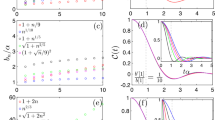Abstract
The inverse compressibility, i.e., the change in the chemical potential as the number of particles in the sample is changed, is studied for a small quantum dot. It is found that the inverse compressibility behaves differently for different values of disorder and electron-electron interactions. For weak interactions or strong disorder one may understand this behavior in the framework of a random matrix theory.
Similar content being viewed by others
References
M. Jammmer, Ph.D. thesis, Hebrew University, Jerusalem.
For more details, see C. Weisbuch and B. Vinter,Quantum Semiconductor Structures (Academic, Boston, 1991).
L. P. Gorkov and G. M. Eliashberg,Zh. Eksp. Teor. Fiz. 48, 1407 (1965) [Sov. Phys. JETP 21, 940 (1965)].
B. L. Altshuler and B. I. Shklovskii,Zh. Eksp. Teor. Fiz. 91, 220 (1986) [Sov. Phys. JETP 64, 127 (1986)].
U. Sivan and Y. Imry,Phys. Rev. B 35, 6074 (1987).
S. N. Evangelou and E. N. Economou,Phys. Rev. Lett. 68, 361 (1992).
F. M. Izrailev,Phys. Rep. 129, 299 (1990).
B. I. Shklovskii, B. Shapiro, B. R. Sears, P. Lambrianides, and H. B. Shore,Phys. Rev. B. 47, 11487 (1993).
R. Harris and Z. Yan,J. Phys. Condens. Matter 5, L493 (1993).
E. Hofstetter and M. Schreiber,Phys. Rev. B 48, 16979 (1993).
V. E. Kravtsov, I. V. Lerner, B. L. Altshuler, and A. G. Aronov,Phys. Rev. Lett. 72 (1994).
S. N. Evangelou,Phys. Rev. B 49, 16805 (1994).
E. Hofstetter and M. Schreiber,Phys. Rev. Lett. 73, 3137 (1994).
E. P. Wigner,Ann. Math. 53, 36 (1951);62, 548 (1955);65, 203 (1957);67, 325 (1958).
F. J. Dyson,J. Math. Phys. 3, 140 (1962);3, 1157 (1962);3, 166 (1962).
M. L. Mehta,Random Matrices (Academic Press, San Diego, 1991).
R. Berkovits,Europhys. Lett. 25, 681 (1994).
R. Berkovits and Y. AvishaiJ. Phys. Condens Matter 8, 389 (1996).
U. Sivan, F. P. Milliken, K. Millkove, S. Rishton, Y. Lee, J. M. Hong, V. Boegli, D. Kern, and M. DeFranza,Europhys. Lett. 25, 605 (1994).
U. Sivan, private communication.
M. Field, C. G. Smith, and M. Pepper, private communication.
M. A. Kastner,Phys. Today 46, 24 (1993); R. Berkovits, M. Abraham, and Y. Avishai,J. Phys. Condens. Matter 5, L175 (1993).
R. Berkovits and B. L. Altshuler, preprint.
Author information
Authors and Affiliations
Additional information
I am grateful to A. Auerbach, M. Feild, B. I. Shklovskii, and U. Sivan for very useful discussions and to the US-Israel Binational Science Foundation for financial support.
Rights and permissions
About this article
Cite this article
Berkovits, R. Interacting electrons in disordered potentials: The inverse compressibility. Found Phys 26, 691–699 (1996). https://doi.org/10.1007/BF02058240
Received:
Issue Date:
DOI: https://doi.org/10.1007/BF02058240




